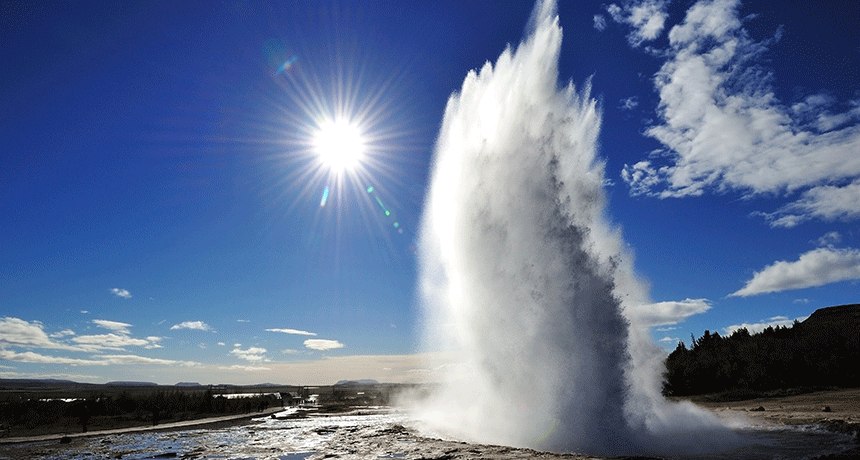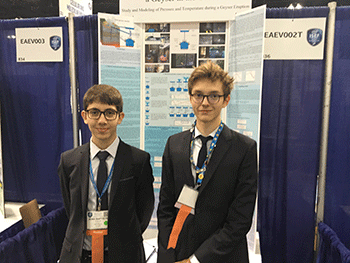To study a geyser, these teens built their own
A pressure cooker and copper tubes become a decent stand-in for a gusher

Geysers, such as this one, are common in Iceland. But two French students didn’t have to travel to the island nation to study the water spouts. They built a model back home.
Cn0ra/istockphoto
LOS ANGELES, Calif. —Yellowstone National Park, Iceland and New Zealand are all known for their geysers. The sudden sprays of hot water from the ground fascinate and delight. They also inspired Jean-Baptiste Flieller, 17, and Elias Suvanto, 18, to investigate how they worked. But there aren’t any geysers near the seniors’ school, Gymnase Jean Sturm in Strasbourg, France. So these teen built their own from a pressure cooker and some copper tubing. What they learned helped them to create a series of mathematical models that describe these water spouts.
Jean-Baptiste and Elias brought the results of their home-cooked geyser to the Intel International Science and Engineering Fair. Created by Society for Science & the Public and sponsored by Intel, ISEF brought together almost 1,800 high school scientists from more than 75 countries, last month, to share their research projects. The pair’s project earned them an award of $1,000 in the Earth and Environmental Science category. (The Society also publishes Science News for Students and this blog.)
A geyser erupts from a hot underground pool of water that has a narrow vent to another pool of water at the surface. The heat from nearby magma warms surrounding rocks. This, in turn, heats the water. The surface water is cooler than the water below and presses down on it. This pressure prevents the water underground from boiling until it is superheated — hotter than 100° Celsius (212° Fahrenheit), the temperature at which water boils at sea level.
The hot water is less dense than cooler water above it, and starts to rise to the surface. “If the water can move up gradually, then the pressure is released gradually, and you get a hot spring,” explains Anne Jefferson. She is a geologist at Kent State University in Ohio. “To get a geyser, you get all of that superheated water moving back up through the voids and fractures” in the rock. But instead of rising gradually, it gathers together in a pool or in very porous rock.
As the hot water rises up, pressure decreases, and the water boils. This creates steam bubbles. But underground and surrounded by rock, it has no place to go — unless there’s a narrow vent to the surface. At first, the steam bubbles may rise and block the vent, increasing the pressure below even more. Then, it all becomes too much. The underground water surges up through the narrow vent and explodes into the air, sometimes more than 42 meters (140 feet), like Yellowstone’s famous geyser Old Faithful.

“We are very excited about geysers. We like the phenomenon,” says Elias. “So we asked ourselves how does it work and how can we model the different phases,” of a geyser’s eruption. Unfortunately, France doesn’t have any geysers. In fact, Elias and Jean-Baptiste have never seen one in person. However, Elias notes “we’ve seen lots of videos.”
To study geysers, the teens had to build a model. They knew they would need a pot of water that could reach high temperatures. The water would have to exit from a narrow vent in the pot to a cooler pool of water. The teens took a pressure cooker — a type of kitchen pot that cooks food at high heat and pressure — and hooked it up through a hole in the lid to six meters (almost 20 feet) of copper tubing. The copper tubing ended in a pan of water outside Jean-Baptiste’s sister’s bedroom window.
Elias and Jean-Baptiste filled the pressure cooker and pan with water. Temperature and pressure sensors inside the cooker let them monitor what was happening. When they turned it on, the water inside the pressure cooker heated up, the pressure increased — and sploosh! “The water jets get up to 1.5 or 2 meters [5 to 6.5 feet],” Jeap-Baptiste says.
Results make a splash
The teens ran their geyser at least once a week for a year. They made adjustments to their design, took measurements and repaired small problems. Finally, they put all their data together and identified eight stages to eruption.
- First, the water heats up. It heats past the normal boiling point of water without bubbling because of the pressure inside the pressure cooker. Heating continues until the water reaches about 113 °C (235 °F).
- The water finally begins to boil, producing steam and driving up pressure inside the pot. The steam could have even come up and blocked the copper tube above the pot, increasing the pressure even more, Jefferson notes. The pressure inside the cooker rises to 1,600 hectopascals (hPa, a unit of pressure). That’s about half as much as in a typical soda can. When the pressure gets too high, the water then starts to travel up the copper tubing and out the top, into the pan of water above.
- In phase three, the heat and pressure are at their highest, and the geyser sprays high. “The water rises up the column, [at the top] you can see a water dome, and then a water jet,” Elias says. At this point, the temperature has reached 115 °C (239 °F) and the pressure hits almost 1,800 hPa.
- By phase four, the escaping water and steam drive the pressure down. The superheated water inside the cooker boils even more than before and the geyser continues.
- The pressure and temperature drop as the water boils and escapes through the geyser. When the temperature drops beneath 100 °C, boiling stops, and the geyser disappears.
- As the temperature continues to drop back down toward 87 °C (185 °F), the steam still inside the pressure cooker condenses into water.
- The pressure now drops to its lowest point, around 700 hPa. That’s about the pressure inside an inflated soccer ball. This pressure is lower than the pressure of the air outside the cooker, which is around 1,000 hPa. With such low pressure inside the pressure cooker, the cooler water from the pool at the top of the copper tubing is pulled down the tube and into the pressure cooker, filling it back up.
- Once the pressure cooker is filled to the brim, the water pressure spikes up again, from around 700 to 1,700 hPa. It shoots up so fast, the teens report, that the water inside the copper tube stops and reverses direction, causing a loud knocking sound sometimes called a “water hammer.” Then the water begins to reheat, and the cycle begins again.
For each of the model’s stages, Elias and Jean-Baptiste came up with a mathematical equation — a way to show how each change in temperature and pressure takes place.
But the teens won’t be able to know if their model can be used to predict geysers until they can apply it to one in the real world. That might be a little difficult since geysers are fairly rare, Elias notes. Worse, people sometimes destroy them. For example, New Zealand has lost 75 percent of its geysers. Some were lost when the water below was extracted for heat energy. Others were drowned when a dam flooded them out.
Jean-Baptiste and Elias hope that their new understanding could help protect geysers. And with any luck, someday, they might get to see — and study — a real one.
Follow Eureka! Lab on Twitter







